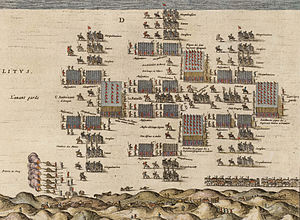Army of Flanders
| Army of Flanders Ejército de Flandes |
|
|---|---|

The Army of Flanders' deployment for the Battle of Nieuwpoort (1600).
|
|
| Active | 1567–1706 (dissolution) |
| Country |
|
| Allegiance | King of Spain as hereditary prince of the Low Countries |
| Branch | Spanish Army |
| Type | Tercio |
| Role | Security, control, and defense of the Spanish Netherlands |
| Size | 10,000 (1567) 86,235 (1574) 49,765 (1607) |
| Garrison/HQ | Brussels |
| Disbanded | 1706 |
| Commanders | |
| Notable commanders |
|
The Army of Flanders (Spanish: Ejército de Flandes) was a multinational army in the service of the kings of Spain that was based in the Netherlands during the 16th to 18th centuries. It was notable for being the longest-serving standing army of the period, being in continuous service from 1567 until its disestablishment in 1706. In addition to taking part in numerous battles of the Dutch Revolt (1567–1609) and the Thirty Years' War (1618–1648), it also employed many developing military concepts more reminiscent of later military units, enjoying permanent, standing regiments (tercios), barracks, military hospitals and rest homes long before they were adopted in most of Europe. Sustained at huge cost and at significant distances from Spain, the Army of Flanders also became infamous for successive mutinies and its ill-disciplined activity off the battlefield, including the Sack of Antwerp in 1576.
The Army of Flanders formed the longest standing army in the early modern period, operating from 1567 until 1706. It was established following a wave of iconoclasm in the troubled provinces of the Netherlands in 1565 and 1566. The provinces were ruled by the Spanish King Phillip II, and as trouble mounted he decided to reinforce the existing forces of the governor, Margaret of Parma, with a more substantial force. This was both a political reaction against the perceived rebellion, but also a response to the Calvinist views being shown by the protesters, establishing a religious flavour to the military response.
King Phillip's possessions stretched across Europe, and were reflected in the creation of the new army. In 1567 it was intended that 8,000 Spanish foot and 1,200 horse would form the nucleus of a new army for the Netherlands, to be sent from north Italy via Savoy. It was envisaged at this stage that the total number might potentially reach 70,000 (60,000 foot, 10,000 horse), under the command of Fernando Álvarez de Toledo, 3rd Duke of Alba. The force would be sent through Europe via a sequence of friendly or neutral territories, which would become known as the 'Spanish Road'; surveying of the route began in 1566.
...
Wikipedia
